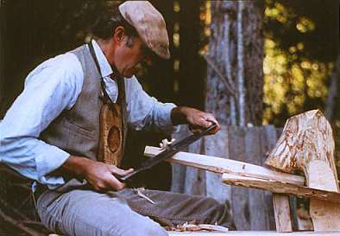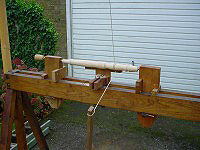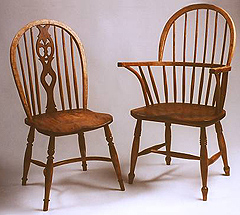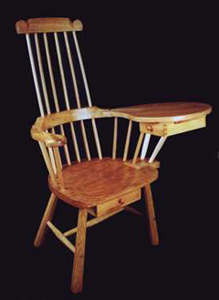
In a town with the unlikely name of Paint Lick, Kentucky, an amazing character plies a bygone trade that sports an equally unlikely name. Don Weber, a quirky, wiry Welshman with the jovial demeanor of a leprechaun, and more energy than a whole Starbucks store, is a bodger.
What’s a bodger? “A bodger,” explains Don in his inimitable Welsh brogue, “is a turner that works in the traditional manner; in the woodlands, on a treadle powered lathe, making the turned legs, stretchers and stumps for Windsor chairs.” A stump is the turned section that holds the armrest up. “Bodger is a British term describing someone who does a rough job of things. They used to turn these legs and sell them by the gross to the factories.” The craft itself, and its name, arose during the Industrial Revolution.
“Prior to that, there were turners on the pole lathe, but bodgers were specifically a group that supplied the factories in High Wycombe, an area west of London. That was the center for the Windsor chair industry. The Windsor chair was the first mass manufactured chair with more than one craftsman making the parts for it. There were bodgers that made the turned parts, bottomers that adzed out the chair seats, and framers and finishers who assembled the chairs. Finishing might consist of being dipped in vats of logwood, a dye, and polished up with an oil varnish. Because I work on the spring pole lathe, I am a bodger. Truth be known, I actually do all three jobs, but my main focus has been the use of the spring pole lathe.”

“The spring pole lathe,” Don continued “was probably the earliest machine outside of the fire drill. By fire drill, I don’t mean youngsters running outside of school when the fire bell rings, but rather a hand drill used to create fire. The same bow and string action that makes the spindle twirl is what is used on a spring pole lathe. A spring pole lathe is a simple, reciprocating, foot-powered lathe whose power comes from a cord wrapped around the turning stock. As the treadle is pressed, the cord spins the wood first one way, then the other, as the turner holds the chisel against the rotating wood stock. Hence, it cuts in one direction, then rewinds itself in the other.”
“The Egyptians were using a lathe in the 3rd century BC with a cord wrapped around the wood, pulled back and forth by a helper in the same reciprocating action. By the 12th century, a springy branch was being used as a return, and a foot treadle allowed one person to run his own lathe.”
“The bodger got paid per gross of chair legs. It cost too much to haul wood from the woodlands to the village, so instead, the bodger would set up his or her lathe in the forest where they cut down the trees. The estate agent, who managed the forest on the squire’s land, would mark trees for thinning. They’d call the bodger into the local pub, and auction off the trees. Then, the bodger would cut the trees, usually beech, rive them, and turn the wood green, since green wood is much easier to turn than dry.” Riving means splitting wood along its grain with a mallet and froe, or riving knife.

“In the 1600s, bodgers got 16 shillings per gross of legs. They would send the rough turned legs to the factory, where they would be stored above the heating furnaces until they were ready to be used, at which point they were dry. The strength of the Windsor chair comes from riving the timber. That’s why the English government made standards back in the 1600s that chairs made for the Parliament or British offices had to be made from riven wood.”
A lifetime working on a treadle lathe is very physically taxing, and certainly keeps one in shape, if Don is any indication. At 61, he looks a decade or two younger, and sports nary an ounce of fat on his muscular frame. Don grew up in Wales and apprenticed at 16 in a joiner’s shop. A joiner is a woodworker that fits wood together. “We did turning, wainscoting and finishing,” he recalled. He came to America in 1972, did a little farming in New Mexico, then moved to northern California, where he set up a shop repairing chairs in 1975.
“I began to research the traditional methods, and went back to Britain on a regular basis to learn the trade of the bodger. I had been mending old English Windsor chairs and was interested in the construction techniques.”
In the mid 1980s, he met Del Stubbs, a well-known turner who at one time also demonstrated the pole lathe; Sam Maloof, Bob Stocksdale, Rude Osolnik, and editor David Sloane at a woodworking conference. They encouraged him to join their ranks, and soon he was writing articles for woodworking magazines and demonstrating his fascinating craft at woodworking shows across the country.
Since then, he’s written articles for newspapers and for a host of woodworking magazines, and even did two television show segments with Roy Underhill for “The Woodwright’s Shop.” He’s a member of the California Blacksmith Association, The American Artisan Blacksmith Association, The American Association of Woodturners, the Association of Pole Lathe Turners, a group for which he is one of the founding members, and the Timber Framer’s Guild, because he also builds timber frame houses. When he has the time, he does workshops at Berea College, a school originally set up as a tuition-free college for poor Appalachian students, and the first interracial and co-educational college in the South.

Since there was no place in America to buy spring pole lathes, Don had to build his own. That, in turn, induced him to build other early woodworking tools as well. In addition to spring pole lathes, he makes shaving horses, bending jigs and even framing tools. “I got into blacksmithing to allow me to make the tools as they were originally constructed. That took me beyond merely using the lathe and got me looking at other trades to learn how their early tools were made.”
Being the doyen of archaic woodcraft techniques puts Don in the perfect position to help those in less developed countries, since his “machinery” is all handmade and uses no electricity. Some years ago, he went to Africa and built a water powered hydroelectric system for a village school in Cameroon. The turbine he built was a design developed in 1876. In October, he is headed off to the rain forest in Honduras to teach locals how to turn green wood bowls on the foot-powered lathe. It’s part of a project to save rain forest wood by having it used. The trees would normally be bulldozed out of the way to get to the more exportable exotic wood trees. Instead, Don will teach the locals how to turn them into something useful that they can sell.
To be fair, Don does own some more typical machines in his Kentucky shop. He has a band saw, table saw, jointer and planer, but says he often finds himself reaching for hand planes and saws instead. The day I spoke to him, he was busy using a Stanley number 12 to level a board. “Good chamfers and tool marks add honesty and texture to your work,” insists Don. “There’s something crisp about a planed or spoke-shaved edge that doesn’t show up on something that has been routed.”
“We are losing the artisan in the work, and losing the understanding of the nature of the wood,” Don laments, then continues with some advice to today’s woodworkers. “Learn how to approach the wood before you attack it with a machine. If you can work with hand tools and do good joinery, you are capable of producing furniture with the skill of an artisan.”





